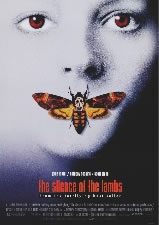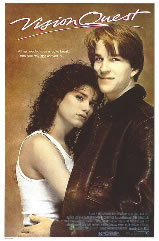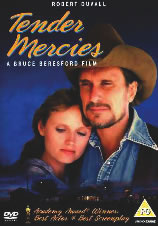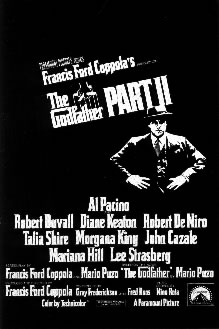Tim Valderrama
Published Issue: Summer 2008
The idea for this article materialized the way most good ideas begin, with friends talking over drinks. On this particular night there was mix of Capitol folks enjoying our second final final when our conversation took a predictable twist. We were running out of things to say to each other and somebody in the group was about to make the leap.
There are only three things politicos discuss on nights like this one...work, sports, and movies-and when we get to movies we always mention The Godfather. And, just to be clear, when I say The Godfather, I’m talking about The Godfather and Godfather II since we all agree the third installment of the trilogy doesn’t exist. In fact, I’m not sure why it’s even called a trilogy at this point.Having already covered work, the fast start of Tampa Bay in the American League, the modern Celtics and Lakers against the Bill Russell-Kareem eras, we started butchering our favorite lines in the two recognized chapters of Francis Ford Coppola’s masterpieces. The leap had been made.
It became apparent for some reason that made sense at the time that a list of the top ten underappreciated scenes in cinema needed to be created-and as the naturally insightful Bluto Blutarsky says in Animal House, “We’re just the guys to do it.”
In order for the discussion to be meaningful we began establishing ground rules. The first and probably most import rule we decided on was that we’d keep the list relatively current. While there were a few classic movies buffs in attendance we didn’t want our list to be filled with scenes from Citizen Kane, On the Waterfront, Casablanca or the wide canon of memorable scenes with Humphrey Bogart. We chose to limit the selections to movies made in the last 40 years.
Secondly, we determined that in order for a scene to be considered underappreciated it must fit into one of two categories. The scene could either be pulled from an enormously popular movie that you would normally associate with a different, more famous scene or it could be the pivotal scene of a lesser known film.
We talked for a bit about two movies where the lead actors are phenomenal without saying a word-Jack Nicholson when he looks at his young friend, the tormented Billy in the private room with the girl who has snuck into the mental hospital in ‘One Flew Over the Cuckoo’s Nest’-it is a quiet, stunning moment in an otherwise wildly unfettered Academy Award performance and we see all of the tragedies of a horribly unfair situation in Nicholson’s face.
The second quiet scene that we thought was impressive was in another Coppola film, ‘Peggy Sue Got Married,” and Kathleen Turner as the middle-aged woman, who is fantastically transported back to high school, walks up the stairs of her childhood home and is flooded with feelings of all that is gone from her life.
We rejected them from the top ten ultimately because we decided that our underrated scenes needed dialogue.
We didn’t come to complete agreement, no one ever does at the Capitol, but in the great new tradition of finding consensus, we came close when we listed the following scenes as moments that could not be cut from their movie without changing it irretrievably for the worse.
10) Magnolia
Directed and written by Paul Thomas Anderson (1999)
“These two that I had and I lost,” are the sad words from an old man in the waning moments of his life. Tom Cruise was nominated for the Oscar for Best Supporting Actor for his role in this film. However, both Phillip Seymour Hoffman and Jason Robards delivered more compelling performances in their scenes together as a male nurse (Phil Parma) and a rich, elderly dying man (Earl Partridge) in his care. There is one scene in particular where Earl, obviously close to death, is talking to Phil about how he repeatedly cheated on his wife and abandoned his family. This beautiful scene, embodying the essence of regret, is made more poignant by Hoffman’s masterful display of compassion and by the fact that Jason Robards is so visibly close to his own final breath.
9) The Lion in Winter
Directed by Anthony Harvey (1968)
Katherine Hepburn made 46 films and was a presence in America cinema for more than sixty years. In 1967 she deservedly won the Academy Award in her swan song coupling with long time lover Spencer Tracy in “Guess Who’s Coming to Dinner.” She followed it up a year later with a period piece, “The Lion in Winter,” playing the aging, imprisoned Eleanor of Aquitaine, the wife of Peter O’Toole’s Henry II. It is safe to say that even by medieval times this was a troubled marriage, and the scene in which she recounts her own list of lovers to the philandering King, a list that includes the previous regent, Henry’s late father, the level of vitriol raised by these two accomplished actors makes you wince.
8) Pulp Fiction
Directed and written by Quentin Tarantino (1994)
The watch: Christopher Walken appears in only one scene in Pulp Fiction, just as he did in another Tarantino film entitled True Romance where he delivers a similar monologue. This scene has it all. There is tremendous delivery by the quirky Walken, someone who almost became a leading man after his Academy Award winning performance in “The Deer Hunter,” and found his place instead as the fascinating character who twitches and hems and voices the feelings of the writer and director. There is dialog only Tarantino could write, a lesson in history, empathy, humor, and it is masterfully shot. More importantly, you get to hear the line, “Five long years, he wore this watch up his ass...then when he died of dysentery, he gave me the watch.” Walken is a guy who has probably never seen most of the movies in which he’s appeared yet he consistently makes the movies better...or, in some cases, the only reason to watch them.

7) Silence of the Lambs
Directed by Jonathan Demme (1991)
Jodie Foster won the Academy Award for best actress opposite the unrelenting performance of Anthony Hopkins as the serial killer Hannibal the Cannibal. The film would not have worked if Foster did not manage to maintain control in the scenes in which she confronts the taunting serial killer. The scene that made it to this list is when she follows the clues and ends up in a storage garage where she finds the human detritus of a murder victim and, instead of trying to be too strong to allow any emotion to fray her FBI character, she responds with an identifiable horror that brings us deep into the movie.
6) At Close Range
Directed by James Foley (1986)
Walken again, and this time as the father of Sean Penn. It is an unbelievably wicked role, and Walken, cryptic, charming, evil, compelling, shines completely. There is nothing he won’t do, including the murder of another son, the assault of Penn’s girlfriend, and the shooting of Penn. There is a scene toward the end of this tepidly good film in the kitchen of Walken’s home when a bleeding Penn threatens to kill his father. Walken’s line, “What, you want me to tell you I love you...hey, I love you,”...is delivered with such entrenched insincerity it makes a mockery of anything the two men might once have shared.

5) Vision Quest
Directed by Harold Becker (1985)
Six minutes: One of the most underappreciated movies of the ‘80s and arguably one of the top ten sports movies of all time. The scene takes place when Louden Swain, played by Matthew Modine, is on his way to wrestle Shute in the big, climatic match. Louden stops by to see a gruff, blue collar co-worker named Elmo who is putting on a suit and a tie that he’s obviously not comfortable wearing. Louden asks Elmo where he’s going and when Elmo says he’s going to the wrestling match, Louden gets angry and tells him it’s not worth missing a night’s pay for six lousy minutes. Elmo responds by giving one of the most inspirational speeches ever caught on film. He describes a day when he happened to be watching the Mexican channel on TV and he sees Pele score a goal upside down and backwards. Elmo concludes his speech by telling Louden the following, “I’m here, sitting alone in my room, and I start crying. That’s right, I start crying. Because another human being, a species that I happen to belong to, could kick a ball, and lift himself, and the rest of us sad-assed human beings, up to a better place to be, if only for a minute...let me tell ya, kid-it was pretty goddamned glorious. It ain’t the six minutes...it’s what happens in that six minutes.” Gets my eyes to well up every time.

4) Tender Mercies
Directed by Bruce Beresford (1983)
This gem of a movie is an attachment of quietly written scenes that add up to a character study that makes Mac Sledge, a drunken western singer finding his soul again, the part played by Robert Duvall, as real and unforgettable as anyone you will ever watch in a movie. The place is west Texas, a barren landscape, and Duvall is hoeing the weeds in the struggling garden behind a ramshackle motel where he works. In a voice that is as tough and as practical as the brown and dusty world he inhabits, he quietly tells the woman who saved him, the completely understated and perfectly cast, Tess Harper, how his daughter’s death in a car accident reminds him again that he doesn’t trust happiness, never has and never will.
3) Deer Hunter
Directed by Michael Cimino (1978)
In 1978, Michael Cimino was on his way to becoming one of America’s greatest directors. He got sidetracked, but this movie ranks right next to the Godfather saga as indelible Americana. There are many scenes that are stunning-including the welcome home for DiNiro’s character, the “Oh, Michael” line uttered by Meryl Streep-but all of the guys in our group said no picture captures better the dynamic of a group of best friends than when John Cazale-who made five films in a career shortened by cancer, and all five films were nominated for best picture in no small part due to his performances-forgets to bring his boots to go hunting deer. An outraged Robert DiNiro refuses to share his extra pair until the peacemaker of the group, a young Christopher Walken, steps in and tells the angry DiNiro to give up the boots...just give him the boots...
2) Jaws
Directed by Steven Spielberg (1975)
Steven Spielberg became somebody great when he directed Jaws in 1975, and the fish was not the only memorable character. Night falls after the crew gets their first look at the colossal shark and the three men wait in the Orca’s cabin. The men are in remarkably tight quarters and the scene is lit by a single swaying light overhead. They get drunk, sing songs, and compare scars. The scene is as entertaining as they come but more importantly it marks a very important transition. Up until this point in the movie Brody and Hooper have shared camaraderie mostly because Quint is beyond surly and borderline mad. However, there is an incisive moment in this scene when Brody wants to be part of the conversation and considers putting his scar from an appendectomy up against the others-he doesn’t, because the scars the Captain lives with are revealed to be deeper than ever expected, the kind of scarring that is in memory and leaves a man hateful and less human. By the end of this scene you realize that the movie’s hero is afraid of the water, chasing an enormous, man-eating shark, and trapped on a boat with not one but two lunatics.

1) The Godfather II
Directed by Francis Ford Coppola (1974)
The greatest sequel ever produced gave us the “that man’s name was Moe Green” line all of us agreed was the key to justifying the amorality of the Godfather saga. The line was uttered in a hotel room in pre-Castro Cuba when Hyman Roth tells Michael Corleone, in the role that was the first indication that Pacino was going to be a legendary actor-that either money is left for a deal to be made or Roth will understand they are not partners. There was universal agreement that this is the most overlooked and underappreciated scene in any Godfather movie and it was actually the impetus for this article. The scene stands out for three reasons: 1) Roth deftly lets Michael know he’s aware Michael is responsible for Moe Green’s death. 2) This is the first moment since Michael takes control of the family where it is evident that he’s facing off against a true equal. The speech concludes with the telling line, “This is the business we’ve chosen. I didn’t ask who gave the order because it had nothing to do with business,” 3) Strasberg, who is more famous for being the patriarch of American method acting than for his film roles, clearly illustrates in this scene-stealing moment that the teacher knew what he was doing.

